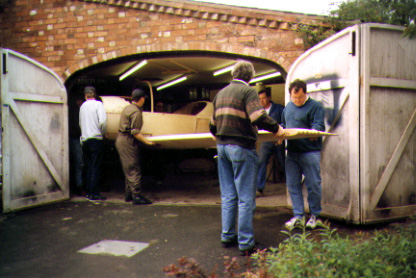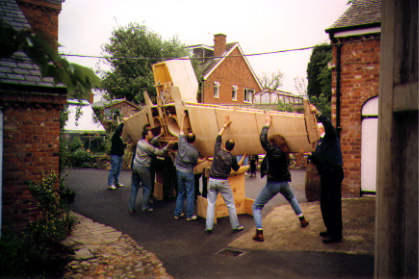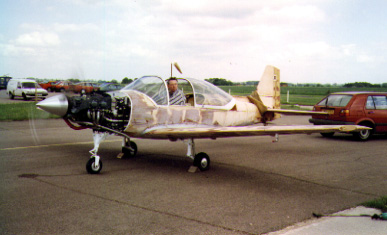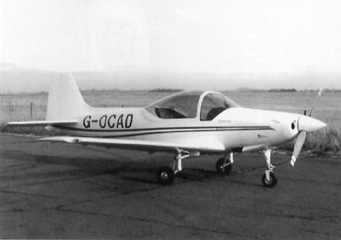First Flight:
G-OCAD
![]()
First Flight:
|
|
by Clive Garrard
This article appeared in the March 1997 Falco Builders Letter. |
Although the following article is about 4 people building a Falco, I apologize in advance if it reads somewhat personally, but I drew the short straw when it came to this particular job allocation!
I started flying in 1988, having overshot the 40 watershed by a couple of years. As long as I can remember, I have gazed up at passing aircraft and dreamed of flying. Some of my earliest memories are of Spitfires, Hurricanes and Lancasters-since I lived close to Martlesham Heath in Suffolk, a WW1, WW2 and post-war RAF testing station-and once, a B36.
However, the possibility of becoming a pilot myself had always seemed so remote that I had never considered it, until I had a major change of circumstance and became an employee instead of an employer. This left my ego dented but my finances healthier, together with the sudden realization that life is indeed not a rehearsal.
Why then, shouldn't I fly?

There was of course no reason, so it was straight into training with no trial lesson. Some time after gaining my licence and having flown a few times with a fellow club member, I joined him in the ownership of a Piper Warrior-albeit my share was small by comparison with his. He eventually traded up to a new and more sophisticated type, which left me grounded again but with my money back. But the bug had bitten, and I wanted my own aeroplane-or at least one I jointly owned. So, by talking to other friends and contacts in our flying club, the idea of our Falco was born.
The three original members were myself, David Nowill and Arthur Crabb. I am a product designer, (art college trained-not an engineer), David was a dentist, (now happily retired but working even harder in his own workshop and on our flying club airfield) and Arthur, who runs his own machine tool trading business. We all have manual skills which we enjoy using, but none of us are at all wealthy, so we took the early decision to build as much as we could from plans. Interestingly and very soberingly, our 1991 estimate of the costs was about half of the final total. The difference has been a combination of the effects of inflation over five years, the unknown costs of freighting those parts which we had to purchase from the USA, Value Added Tax (at 17.5% on all purchases!), avionics, paint and a host of other unforeseen things.
(For those UK builders who are not yet aware of this, we did not have to pay duty on our imports and nor should you. You have to register with Customs and Excise as an aeroplane builder, and you will be allocated an End Use Number-which makes your imports duty free! )
Almost inevitably over that period of time, the membership of the team changed and in our case, Arthur left, to be replaced by Gordon Blunt. Gordon is a planning manager for a major credit card company and is the only one amongst us who claims to enjoy acrobatic flying, or aerobatics as we know it. He is also a very keen cyclist and Morris dancer (it is said you should try anything once, except incest and Morris dancing)! Morris dancing is an ancient English custom intended to celebrate the fecundity of spring and summer. The dancers (usually a group of six menopausal men) dress all in white for purity, wear ribbons and flowers (even a Falco badge) for fertility, and clash stout ash sticks and sometimes each other, to frighten away evil spirits. This usually takes place outside a village hostelry and is very strenuous-requiring much refreshment. The prime requirement for a Morris dancer is the ability to assume a vertical attitude after the consumption of much ale, without the aid of an artificial horizon or safety net.

We decided to start building in David's workshop, which incidentally is only 3 miles from the airfield, even though we knew it was not big enough for a complete Falco. We hoped that if we kept our heads down for long enough, something would turn up, so we laboured away for a year or so on fuselage frames, ribs, tail group spars etc, and then two things happened which finally required some decisions to be made. A pair of healthy engines turned up on the market from a severely bent twin Comanche which had been unintentionally reversed into a railway embankment, following a double engine failure (the result of having no fuel aboard), and we decided to knock down an intervening wall in the workshop and push another one further out.
In the case of the engine it meant a couple of long drives (by British standards), to near Stonehenge in order to first inspect one and then buy it. On the second trip, which was in our Aero Club pick-up, David demonstrated how to lose but immediately catch the tail of the pick-up on a wet bend. As he said, 'it is very gentle in the stall'-unlike the Falco, which to me seems very positive!
On the workshop front however, we knew we were rapidly making parts which when assembled together would be too big to fit in the current space. It was obvious we had to plan for the capability to make the wing spar and ultimately the aeroplane under one roof-hence the missing wall and extended length. Even then we knew we would not be able to do a complete assembly of the aeroplane until it was off-site and in a hangar. At times we had an engineless Falco and at others, we had one with the engine but no tail. Even when the tail was in place, there was no room for the rudder or elevators and there had to be a hole in the ceiling for the top of the fin.

David Norwill testing the Falco.
We finally moved all the parts to the airfield on May 4, 1996 and assembled it completely for the first time-much to our delight. June 12 was our first engine run (lots of fingers crossed, fire extinguishers etc), and we had only two problems-a misfiring cylinder (caused by the inhibiting fluid), needing a new plug and a little bit of finger trouble with the oil filter ("I admit it"-David). A democratic decision was taken by David and me. We therefore gave Gordon the job of cleaning the oil off the engine, firewall and underside of G-OCAD, because he's the apprentice and needs the experience. He's also smaller than either of us, so quite (un)reasonably we boss him about!
Following painting and final hook-up of all control surfaces etc, we had our second engine run on 28 October. I happened to be in the driving seat, so once the engine checked out okay, I had the pleasure of being the first of us to release the brakes and let her roll. At the time, it seemed like a real milestone-to control and feel the aeroplane that we had made with our own hands over more than 5 years-there was, I think, justifiable cause for a deep sense of satisfaction-and not a little celebration!
Through November we were engrossed in the upholstery, final checking, weighing and preparation of all the paperwork. I know it's been said many times before, but it is worth repeating-that an aeroplane is not ready to fly until the weight of paperwork equals that of the aeroplane itself. At the time, we thought we were in a race with Andy Hart, our chief flying instructor, who we had selected (or should I say, who had selected himself), to be the test pilot, because he was due to travel to Oklahoma in the U.S. and fly back a Cessna 182 RG. As the route he was going to fly was via Goose Bay, Greenland, Iceland and Scotland, we thought we would be ready before he was back. We were not! He arrived back safely, and we were still waiting for the Permit to Test to come through from the PFA (the British equivalent of the EAA) .
Incidentally, while I was rummaging through some old photographs of mine in that loose-end period, I discovered that many years ago I had photographed a production Falco at Ipswich Airport, in Suffolk, England. I cannot accurately date this, or even remember doing it, but I do know that it was sometime in 1970, because I was completing my masters degree in design and had my first 35mm camera. On the same roll of film as that Falco, my fellow students and I appear in our graduation gowns. What a sight! Little did I know then, that 26 years later I would be involved in building one-perhaps there was something about the design that I was attracted to even then.

It took three weeks for the permit to arrive and as soon as it did, we were at the airfield itching to go-but of course, no matter how much we encouraged each other about the weather improving, it did not. Complete cloud cover at 1000 ft is definitely not first-test-flight weather, especially in the UK, where all homebuilt aircraft are restricted to daylight VFR only.
However, on December 21, while I was on a brief vacation in Germany, the weather conditions, David, Gordon and the availability of our test pilot Andy all came together, so with my previous blessing of "here's my girlfriend, play with her if you can while I'm away", G-OCAD flew for the first time.
The first flight was faultless, but the second one wasn't! The engine had now been in our possession for 4 years-inhibited but not run until June. Although we had installed new hoses and lines elsewhere, we had not renewed any of the engine accessories or injector lines, but we had had the injectors and fuel distributor cleaned, and the engine had run on the ground for something like a total of 2 hours.
On the second flight Andy experienced an engine misfire and hastily beat it back to the field. David removed the injectors and sucked some debris from one of them which seemed to cure the problem. Both he and Gordon had subsequent observation flights with Andy, and the engine seemed as smooth as a pint of Guinness, (do you think we could get some sponsorship from this?). I arrived home that night and had my first right-hand-seat ride on Sunday 22 Dec. After all those years of lovingly caressing spruce and sucking Aerolite off my fingers-one of which I nearly removed with a 1" chisel, (how could I do that, being a self-proclaimed wood craftsman?)-the experience of flying and feeling this aeroplane was magnificent. It's so responsive and although I've never flown a little jet fighter, that's how it feels to me. It does what you think and zooms effortlessly about the sky-and the visibility is so good! And so to the testing.
The Permit to Test stipulates a minimum of 5 hours testing, including a 2-hour cross country flight, before a Permit to Fly can be considered. All this has to take place within a 25-mile radius of the airfield. Can anyone other than a bureaucrat explain this? We had visions of going round and round like the proverbial bluebottle, but it works out at only two complete circuits plus the climb out and descent. However, when David began planning a route, he realised that the several blocks of controlled airspace and many cities that surround us, (another condition of a UK Permit to Fly is that we cannot overfly settlements), would leave us with very little reasonable space to fly in for that length of time. Luckily, we have an understanding and accommodating PFA, who allowed us to extend our limit to 40 miles. That made it possible to plan a larger and more sensible circuit.
The cross country went without hitch on Friday 27 December, which was a day that started poorly, but with high pressure over the UK, became wonderfully clear and cold. Andy taped up our Peugeot 106 air vents (I spotted them in my wife's car, but commonsense prevailed, and we installed new ones, rather than pinch hers), because even when closed, we are getting too much sub-zero air in! David also welcomed the tape, as he was the observer for that part of the test schedule.
Over a few coffees, we planned the next day's testing, which meant draining fuel from the rear tank so that Gordon could be on board for the aerobatic test-limited to 1650 lbs, to be followed by a fill-up, with me aboard for the flight test.
Saturday dawned even worse than Friday, with fog and a visibility of less than 3000 meters. Miraculously, by 11:30 the sky was a clear, deep azure. We had moved the fuel by then, so off went Gordon and Andy. David and I were mooching about in our own worlds when the message came over the club's loudspeaker that they were on their way back with a misfiring engine! Much gloom and despondency, plus very keen attention on their return to the circuit. With the obvious diagnosis of more sh_t in the injectors, we removed them and did indeed find some. After a very thorough ground engine run, Andy and Gordon were back in the air to finish the test-which was completed without further hitch.
After lunch and a complete refuelling, it was my turn for an observation/record-taking ride in the maximum all-up-weight flight test. The visibility was fabulous, and our home-made heat valve worked very well. While not feeling excessively hot or cold at any point, the OAT was 7C at 4000 ft, the cabin was pullover-and-shirt comfortable-or was it that we were both sweating at the prospect of the Vne test?
It was a faultless test however. Andy said he had never flown an aircraft at Vne that felt so smooth, sound and comfortable. On the way back to the field, we caught up and formated with a Piper Cherokee being flown by my first flying instructor, who had taken me through and a little beyond my first solo, 8 years ago. Andy seemed to be able to fly the Falco with great precision and confidence, and he said afterwards, "if you had said to me before I flew this aeroplane, that in little over 5 hours time I would be flying precision formation in it, I would not have believed you".
(I must stress at this point that I was not handling the aeroplane. It was in Andy's very experienced hands-and the Cherokee was under equally capable control. No low-hours/new-to-Falco pilot should ever consider doing this).
However, that seems to sum up the flying qualities of the Falco. It responds immediately to every small, precise input, without hesitation or exaggeration and is therefore extremely rewarding to fly. Andy found that he very quickly became comfortable in it and was most impressed not only by its acceleration, but also by the way it rapidly slows down for such a slippery ship-no doubt in part because of its low mass and inertia. I can see we are going to have to let Andy play with it at times in the future, partly because he has done a superb job of testing it for us so far, but also because he has waited a long time for this as well-in fact he bought a set of plans about ten years ago, but only needed an afternoon to realise that building one was out of his league.
During the tests, which by their nature are not envelope-pushers, we found the Falco needs no trimming at all-except that it does have a slightly heavy left wing. We have decided to ignore this for the immediate future. She cruises at 150 kts at 65%, climbs from 500 ft to 1500 ft in 58 seconds at 25/25 and in 42 seconds at 25/28. The clean stall is at 55 kts.
So the PFA testing is complete and the reports sent off. Now we have to twiddle our thumbs again until we finally receive our full Permit to Fly. However, not all the time will be wasted because we unanimously decided to replace all the existing injector lines with new ones, which should clear up that little problem-we should have done it earlier. Our belief is that although the engine was inhibited, there was of course no treatment applied to the injector lines, and that these dried out leaving some sort of deposit on the inside walls. Once fuel flowed through them again, and they had been subjected to a period of engine vibrations, the scale started to shake loose and end up in the injectors.
The flight test results were sent off on 31 December with us eagerly expecting our full Permit To Fly to return in a couple of weeks. Inexplicably, it took a day over seven weeks for the document to appear. Inevitably, the weather had taken a turn for the worse again, but we Brits are made of stout stuff, so David and Gordon checked out with Andy on 20 and 21 February (while I was at work), with me completing mine on 1 March-all in winds of 20-30 kts and on a 490-meter runway. These might not seem like ideal conditions, but in this country, if you can't fly in such weather, you often don't fly at all. I also suspect that Andy was pushing our personal envelopes. For me, it was exactly 5 years 6 months from starting the Falco on 1 September 1991 to flying it for real.
Working on this project for over 5 years of weekends and evenings, has moulded us three individuals, with little previous social contact, into a team to be reckoned with-a team that often seems telepathic. Very often words were not needed during specific jobs. We each knew what was going on and the tools or components to hand to the principal worker without being asked for. It has been fun, a real labour of love, a learning experience about aeroplanes and colleagues, and life changing.
Would we do it again? No. (David says yes-but when he's retired-again!)
Have we enjoyed doing it? Most positively, yes!
Have we got the best Falco ever built? Of course we have.